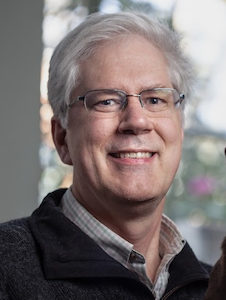
Daniel Gavin
Education
B.A., 1992, Dartmouth College; M.S., 1997, Ph.D., 2000, U Washington (Seattle). (2006)
Research Interests
I am a biogeographer interested in understanding present and past responses of Earth's biota to climate change. The overarching theme of my research is the influence of climate change and climate-mediated natural disturbances on the composition and structure of forests, at several scales in space and time. My specific interest lies in reconstructing forest composition and natural disturbances over recent history (hundreds of years) and more distant history (thousands of years) using interdisciplinary research designs. For example, sediment records extending back to the last Ice Age (18,000 years ago) or earlier allows us to address how populations and communities reorganize through periods of fast and slow climate change. Shorter sediment records of only the past 2000 years provide context for human-induced impacts of the last 200 years. And tree-ring records of the past 400 years can be used to address tree population dynamics at annual resolution. While most of my graduate training was in sediment-based paleoecology of forests, I have subsequently branched into other subfields of biogeography as well as the sediment record of flooding and erosion.
Publications
Selected recent publications: [Google Scholar profile]
Gavin, D.G., Struble, W.T., Fonstad, M.A., 2024. Holocene lake sediments reveal alluvial fan history with links to climate, wildfire, and earthquakes. Journal of Geophysical Research: Earth Surface 129, e2024JF007778. https://doi.org/10.1029/2024JF007778
Hendricks, L.B.†, G.Z. Anshari, and D.G. Gavin. 2024. Fire in the rainforest: A 3,200 year history of fire in a West Kalimantan, Indonesia tropical rainforests. Ecosphere. .
Ruwaimana, M., Gavin, D.G., Anshari, G., 2024. Interplay of climate, fires, floods, and anthropogenic impacts on the peat formation and carbon dynamic of coastal and inland tropical peatlands in West Kalimantan, Indonesia. Ecosystems 27, 361–375.
Fernandez, M.C., F.S. Hu, D.G. Gavin, G. de Lafontaine, and K.D. Heath. 2021. A tale of two conifers: Migration across a dispersal barrier outpaced regional expansion from refugia. Journal of Biogeography 48: 2133-2143.
Ruwaimana, M., G.Z. Anshari, L.C.R. Silva, and D.G. Gavin. 2020. The oldest extant tropical peatland in the world: a major carbon reservoir for at least 47,000 years. Environmental Research Letters. doi:10.1088/1748-9326/abb853
Gavin, D.G., A. White, P.T. Sanborn, and R.J. Hebda. 2020. Deglacial landforms and Holocene vegetation trajectories in the northern interior cedar-hemlock forests of British Columbia. in R.B. Waitt, G.D. Thackray, and A.R. Gillespie, editors. Untangling the Quaternary Period: A Legacy of Stephen C. Porter. Geological Society of America Special Paper 548. doi:10.1130/2020.2548(05)
Colombaroli, D., D.G. Gavin, and A.E. Morey. 2018. Watershed erosion estimated from a high-resolution sediment core reveals a non-stationary frequency-magnitude relationship regulated by internal feedbacks. Earth Surface Processes and Landforms 43: 2181-2192.
Herring, E.M., D.G. Gavin, M. Fernandez, and F.S. Hu. 2018. Ecological history of a long-lived conifer in a disjunct population. Journal of Ecology 106: 319-332. doi:https://besjournals.onlinelibrary.wiley.com/doi/10.1111/1365-2745.12826
Schwörer, C., D.G. Gavin, I.R. Walker, and F.S. Hu. 2016. Holocene treeline changes in the Canadian Cordillera are controlled by climate and local topography. Journal of Biogeography 44:1148-1159. doi: https://onlinelibrary.wiley.com/doi/10.1111/jbi.12904
Gavin, D.G., and L.B. Brubaker. 2015. Late Pleistocene and Holocene Environmental Change on the Olympic Peninsula. Ecological Studies Vol. 222. Springer. 144 p.
Gavin, D.G., M.C. Fitzpatrick, P.F. Gugger, K.D. Heath, F. Rodríguez-Sánchez, S.Z. Dobrowski, A. Hampe, F.S. Hu, M.B. Ashcroft, P.J. Bartlein, J.L. Blois, B. C. Carstens, E.B. Davis, G. de Lafontaine, M.E. Edwards, M. Fernandez, P.D. Henne, E.M. Herring, Z.A. Holden, W. Kong, J. Liu, D. Magri, N.J. Matzke, M.S. McGlone, F. Saltré, A.L. Stigall, Y.-H.E. Tsai, and J.W. Williams. 2014. Climate refugia: joint inference from fossil records, species distribution models and phylogeography. New Phytologist 204:37–54.
Teaching
- 2024-2025
- Geog 323: Biogeography
- Geog 430/530: Long Term Environmental Change
- Past years
- Geog 141 The Natural Environment
- Geog 433/533: Fire and Natural Disturbances
- Geog 423: Advanced Biogeography (recent topics: Landscape Ecology; The Biodiversity Crisis; Dendrochronology)
- Geog 607: Quantitative Methods in Paleoecology
